VMware Earnings: 5 Big Takeaways On vSphere, Dell And SaaS
From its upcoming vShpere as-a-Service offering to plans of forming new vendor partnerships across the industry as a stand-alone company, here are the five most important takeaways from VMware’s third-quarter financial earnings report Tuesday.
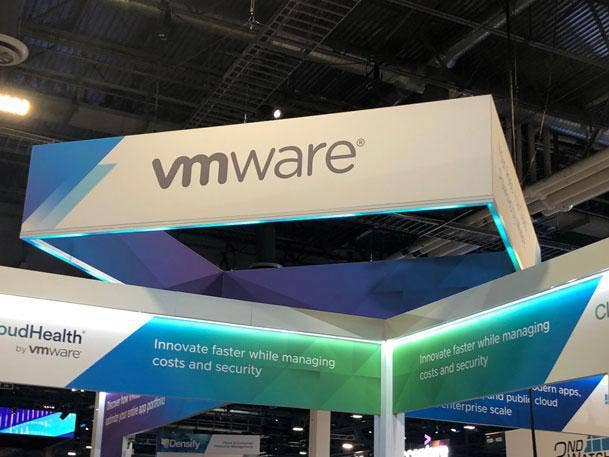
VMware’s Third-Quarter Earnings And Vision For 2022
VMware’s total revenue climbed 11 percent year over year to nearly $3.2 billion during its third fiscal quarter 2022, as the virtualization superstar reported its financial earnings results Tuesday as an independent company for the first time since 2004.
“As a stand-alone company, we have more strategic and financial flexibility to deliver on our multi-cloud strategy,” said VMware CEO Raghu Raghuram during the company’s earnings call with media and analysts Tuesday. “We are also able to partner even more deeply with all the cloud and on-premises infrastructure companies to create a better foundation that drives results for our customers.”
The fast-growing Palo Alto, Calif.-based company also unveiled some key revenue numbers for its current fiscal quarter as well as new product offerings slated for 2022.
CRN breaks down the five biggest things channel partners, investors and customers need to know about VMware’s third-quarter earnings results as well as insight into VMware’s future, including when vShpere as-a-Service—code-named Project Arctic—will officially hit the market.
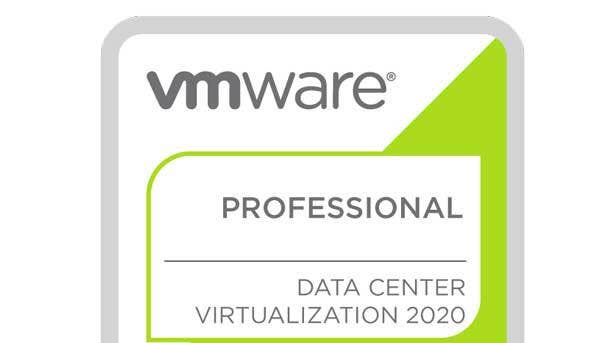
Vendor Partners Are ‘Staffing Up’ On VMware-Certified Personnel Post-Dell
Raghuram said a tailwind is brewing as vendors are now “staffing up” on VMware-certified personnel, aiming to form new go-to-market and joint product offerings after Dell Technologies spun out its majority stake in VMware this month.
“We are seeing a sense of excitement and possibility from the partners that are already planning to or are starting to staff up on their VMware expertise. We are talking to other partners about what we could do to help them further in the markets where we could have joint solutions,” said Raghuram.
Round Rock, Texas-based Dell Technologies spun out its majority stake in VMware to Dell shareholders on Nov. 1, opening up new opportunities for VMware to form new or enhanced technology partnerships and go-to-market strategies with other companies. Raghuram said as an independent company now, other vendors are starting to add VMware-certified experts.
“So all these conversations have started happening. These all have different timelines depending upon whether they’re purely go-to-market or they involve technical collaboration and joint solutions, etc.” said Raghuram. “So I do expect to start to see some results over the course of the next year. Like I tell our internal employees, day one for us post-spin-off [from Dell] may not look very different, but in day 365, you’ll see the benefits of it.”
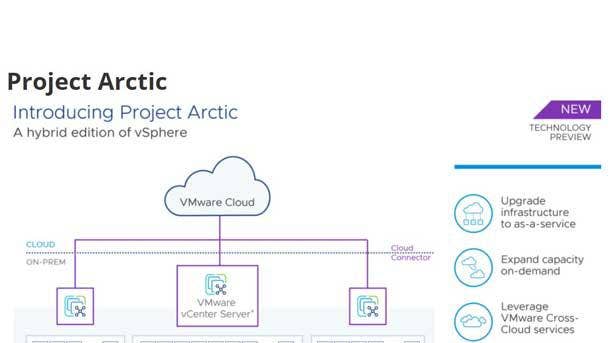
Project Arctic For vSphere To Hit The Market Next Year; ‘Healthy’ Gross Margins Expected
Last month at VMworld 2021, VMware unveiled a technology preview of Project Arctic—a new architecture for vSphere. Raghuram has described Project Arctic as basically vSphere as-a-Service that streamlines customers’ journeys to the cloud.
“Project Arctic will bring the power of cloud to customers running VMware vSphere on-premises. It will enable cloud-based management for hundreds of thousands of vSphere customers and vSphere deployments around the world,” said Raghuram.
With Project Arctic, customers will be able to benefit from life-cycle management, cloud disaster recovery and cloud burst capabilities as an extension of their vSphere deployments, said the CEO.
“We will bring Project Arctic to market next year as the next step in making our portfolio available in a subscription and SaaS form factor,” said Raghuram.
“We expect this to be a win-win solution for the customer, helping them lower their management costs and also give them capabilities that they did not have before, lower their cost of ensuring security, etc. And from a VMware perspective, it will allow us to deliver more value to these existing customers,” said Raghuram. “We expect this to be a healthy gross margin business.”
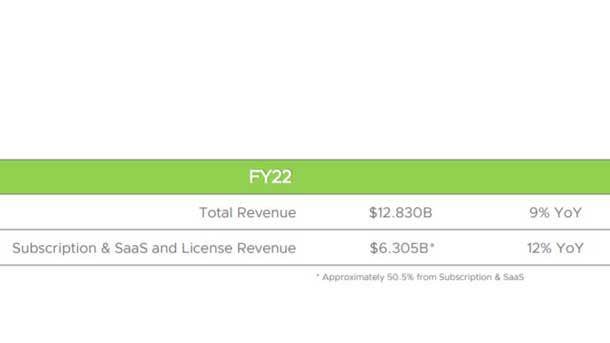
New Sales Guidance For Entire Fiscal Year 2022: $12.83 Billion
In a bold move, VMware unveiled sales guidance for its entire fiscal year 2022, which ends Jan. 31, 2022.
VMware is expecting to generate $12.83 billion in total revenue for fiscal year 2022, representing an increase of 9 percent year over year.
The company is expecting subscription, SaaS and license revenue to reach $6.3 billion, with approximately 50 percent of that being solely subscription and SaaS. The $6.3 billion would represent an annual increase of 12 percent compared with fiscal year 2021.
“We are increasing guidance for non-GAAP operating margin for the full year to 30 percent and non-GAAP earnings per share to $7.19 on a diluted share count of 422 million shares,” said Zane Rowe, executive vice president and CFO of VMware, during the company’s earnings report. “We are also increasing our cash flow from operations guidance to $4.1 billion and increasing free cash flow expectations to $3.7 billion. This reflects our performance in Q3 combined with our outlook for fiscal year 2022.”
Looking at its current fourth-quarter 2022, VMware is projecting total revenue to reach $3.51 billion, which would be a 7 percent increase year over year. VMware’s subscription, SaaS and license revenue is expected to hit $1.87 billion during its fourth quarter, up 9 percent year over year.
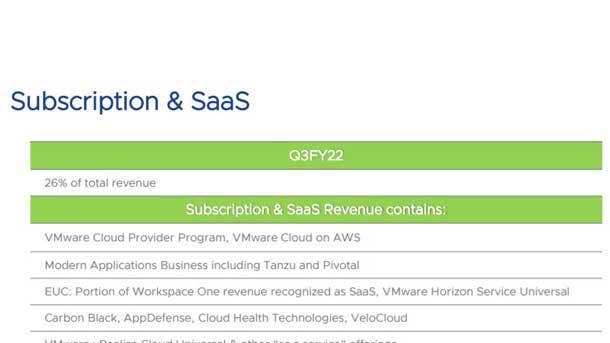
Subscription And SaaS Skyrocket 21 Percent
VMware has been successfully striving to shift more of its total software revenue into subscription SaaS sales. Quarter after quarter in its fiscal year 2021, VMware has grown subscription and SaaS sales at a double-digit clip.
For its third quarter, VMware’s subscription and SaaS sales soared to $820 million, up a whopping 21 percent year over year.
Raghu said he’s pleased with VMware’s overall bookings in the quarter as the company continues “to scale our subscription and SaaS” offerings.
“We saw strong year-over-year product bookings growth in major product categories. Core [software-defined data center] product bookings increased over 20 percent year over year. Compute was up low double digits, and cloud management was up strong double digits year over year. Both of these were helped by our multi-cloud subscription and SaaS offerings,” said VMware’s CEO.
VMware’s license revenue climbed to $710 million, up from $639 million in third-quarter 2020. Total services revenue was $1.66 billion, an increase of 7 percent year over year.

VMware Vision For 2022: Become The World Leader In Multi-Cloud
The goal for 2022 is to make VMware the multi-cloud software titan of the world via new joint go-to-market partnerships, thanks to its new independence, along with driving subscription and SaaS sales to the next level.
Raghuram (pictured) said VMware is gaining momentum across its vast software portfolio—from security and virtualization to containers and hybrid cloud.
“We saw momentum in VMware Cloud, which includes hyperscalers such as Amazon [Web Services], Microsoft, Google and Oracle. We also continue to drive innovation in new product offerings across our Carbon Black Cloud and Tanzu platforms. NSX increased in the low double digits versus Q3 last year, and vSAN grew in the high teens year over year. EUC [end-user computing] product bookings as well as subscription and SaaS ACV [annual contract value] bookings were up in the strong double digits year over year,” said the CEO.
In 2022, VMware will continue to “expand and advance” its offerings to meet the needs of customers in three ways.
“One, deliver a cloud-native app platform for building modern applications in a public-cloud-first world. Two, migrate enterprise applications to a cloud-agnostic infrastructure. And three, build out the secure edge to optimize across our workspace and edge-native applications,” said Raghuram. “It’s clear that multi-cloud will be the model for digital business for the next 20 years, and in this vibrant dynamic marketplace, the pace of innovation is relentless—and VMware is at the center of it.”